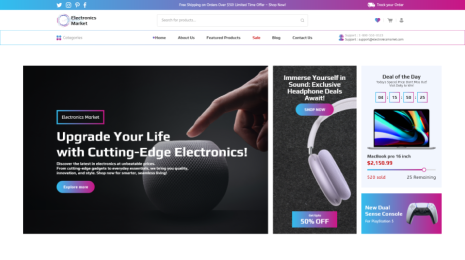
Introduction
Do you find it difficult to locate the data you require in Google Analytics anymore? Wish your reports could be easily customized?
Additionally, you'll discover where you're losing important traffic due to 404 pages and receive recommendations on how to get that traffic back.
This article contains a step-by-step guide on how to create and store useful custom report in Google Analytics.
1. Select the Source or Medium Report
Among the most typical issues with Google Analytics is how irritating and difficult it can be. But you can customize reports or rapidly get the solutions you need by making a few small modifications.
The source/medium analysis will be the first thing we examine. Choose Acquisitions > All Traffic > Source/Medium to access it.
Due to the fact that my systems employ UTMs (urchin tracking modules) to ensure that the data is present, users might not be able to view all of those sources of traffic in their own version of Google Analytics.
Once you've set up UTM settings, the source/medium report is going to build itself. Although this information is instructive, it is also rather broad.
You can see numerous sources of traffic coming in and a variety of responses coming from these traffic sources if you check the source/medium report, but how do you know which of these are actually producing leads? Here is how to alter the source or medium analysis to obtain the information you need.
2. Select your objective to locate traffic sources that generate leads
To get details on your leads, choose your lead-specific Google Analytics objective from the Conversions menu.

The report details which traffic sources are generating leads for me as well as how many leads I've been receiving from each source.
It's very easy to set up objectives in Google Analytics if you haven't previously.
3. Add an Additional Dimension to Lead Generation Campaigns for Reveal
What if one wanted to find out the sources of traffic for specific campaigns?
For instance, I've got a campaign named Win for the courses offered by my business's website, and we receive traffic that begins with a lead. It's possible to set up an additional feature in Google Analytics to view the information for a specific campaign like this.
To examine the campaigns you've launched in addition to all of your sources and mediums, choose the Secondary Dimensions icon and enter "campaign" in the search query field.
If you choose Campaign, a Campaign column will appear in your report beside the Source/Medium column. These are what Google Analytics calls dimensions. The major dimension is source/medium, and an additional dimension is campaign.
You are now able to see the Win campaigns with a few other campaigns when you check in the Campaign section down below.
4. Incorporate a filter to see lead-generating traffic from one campaign
How then can people narrow down the data to only display the campaign that interests them? Select Basic first to get started.
The data will then be filtered by Google Analytics to just display the traffic for this particular campaign. Choose Include from the very first drop-down menu next, and then choose Campaign from the second menu. Enter the campaign name in the text field to the right of the containing menu. Since the UTM information is arriving in this particular case using the word "win," we will enter it.
5. This custom report in Google Analytics can be saved and viewed
Now that you've seen the advantages of customizing a source or medium custom report in Google Analytics, it's likely that you don't want to repeat all of these processes each time you need that data. The good thing is that saving your customized report in Google Analytics is simple.
- The first step is to click Save in the top-right corner of the screen.
- Enter an imaginative name for the report in the pop-up box and press OK.
- After saving your report, you will undoubtedly want to know how to access it again. The report you just saved will appear in the list of saved reports when you select Customization > Saved Reports on your left-hand navigation.
What can be done with this information after you know what number of inquiries are coming in from numerous traffic sources?
In a brief amount of time, that e-commerce-unmasked email has produced for me a respectable number of leads (12) and a respectable conversion rate (36%), in comparison to the other sources of traffic that are coming through.
Only one traffic source—the traffic I received as a result of my recent appearance on social media platforms and the Examiner podcast—has a marginally higher conversion rate. It converts at a 40% rate. According to this information, podcast traffic is a valuable type of traffic for me, so I'll aim to increase my podcast traffic.
This is an illustration of how companies can add Google Analytics WordPress to produce useful marketing outcomes.
6. Customize all pages Report to show 404 Errors
Now that the source/medium report has been altered, you can easily see where the number of visitors is coming from, as you've saved the report after making changes. What happens, then, when you start to lose that traffic as a result of broken links- the famous getting 404 page not found message? Even though you might not be fully aware of what is happening, your visitors are, and with a little adjustment, Google Analytics can also
- This time, in Google Analytics, you're going to customize a different kind of report. Go to Behavior > Site Content > All Pages in the main menu to get this report.
- The next step is to look for a page name that's going to identify your 404s. Enter "page not found" into the search box to do this. You're definitely looking for this phrase since "page not found" is typically the 404 error page's title. Look for that here in the event your 404 page says something different if it doesn't state this.
- You'll see all of the various 404 pages once you press Enter. All of these links were broken. Select the page title to see what the links are.
If someone didn't find the information they were looking for, you are able to observe what they typed in. Instead, they noticed a broken link.
Let's now discuss how to utilize this report
That data is crucial because you'd like to be confident that typing in your links is simple.
This report can also show you whether you sent a message with the incorrect link. You could quickly identify the issue and address it.
In this example, we became aware that people were trying to find the tools they had created, so we changed the design on the 404 page. What do you intend to achieve? After that, it asks users to choose between the toolbox and one of the available courses. It became possible because we used Google Analytics to develop a unique report and noticed that one small change resulted in sales and lead generation. The identical event can be done.
Your customized All Pages report can be saved so that you do not need to create it later. It is identical to the customized report you created earlier. Once more, simply click Save and give it an appropriate title like "404 Report." Once you've clicked OK, you're done.
FAQ:
- What kind of purpose do custom report in Google Analytics offer:
You can combine statistics and characteristics from different custom report in Google Analytics. Private reports enable you to develop a more in-depth understanding of your KPIs rather than relying on generalizations to analyses your marketing performance.
- Which of the methods listed above can be applied to produce a customized report:
The following techniques are available to build a custom report: Exploring the View to Tradition Report Conversion translating a source tree view into custom reporting. Equations are manually entered to create reports.
- Can other people view custom report in Google Analytics:
Only the individual who writes a custom exploration report can see it. Therefore, if you're looking for other individuals to observe these customized reports, you simply must share them. Select the Explore tab in Google Analytics after logging in to view the personal reports you have already made.
- What differentiates a custom report in Google Analytics from a dashboard:
Custom report in Google Analytics are in contrast to dashboards, are frequently more numerically dense, necessitating a little more analysis to extract value from them. There are a few visualization possibilities, such as the typical pie diagram and bar graph, whereas we think that, when suitably organized, reports usually offer more information in table form.
Conclusion
You can easily access the information that will help you find the answers to your inquiries by configuring these two custom report in Google Analytics. You will observe which traffic providers are truly generating leads with the help of the source/medium custom complaint, and you can identify where you're losing important traffic with the help of the All Pages customized report. The best part is that users can store their customized reports for easy access and avoid having to start over them in the future.
Everybody wants their business analytics should show a relative progress every time they check on their report and that's only possible when your site is in good health so that it can attract and retain its users. One can achieve its target by using Premium WordPress Themes on their website which would help their website perform efficiently and gather more users to their website
We hope that this post was help you create a custom report in Google Analytics.









